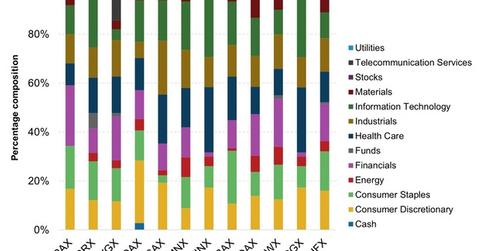Is It Time to Invest in International Funds?
2016 has mostly been about macro trends, thus presenting a different set of challenges for active fund managers who mostly focus on companies rather than economic and sector trends.
Dec. 4 2020, Updated 10:53 a.m. ET

International funds are looking better
When we last reviewed the 12 actively managed international funds in this series, they were having quite a rough time. But in the past two months, things have taken a turn for the better. As the performance graph shows in the first article of this series, a few of these funds (MGRAX) (HLMNX) have not only navigated the year better than others (CWVGX) (NBQAX), they have posted handsome returns. The graph below shows the latest available portfolio composition of each of the 12 international mutual funds that we have individually reviewed in this series.
Macro events have dominated
If we say that 2016 has been a year driven by macroeconomic trends, we would be vindicated by the way global events have impacted financial markets. When the year began, it was almost entirely about the pace at which US monetary policy would be normalized. But an economic slowdown scare from China, which is not over yet, and the “leave” vote by the UK on June 23 have ensured that they dominate the spotlight. The geopolitical landscape, in light of acts of terrorism, has also impacted financial markets.
There is a clear change in sectoral focus among the 12 funds that we have reviewed in this series. Except two (FNGAX) (USIFX), all have changed their top sectoral choice. The top choice for most funds is either financials or information technology. While this shows faith in tech stocks, it also shows that at least some fund managers are expecting higher monetary stimulus, which would benefit financials. Some have added financials because of the thrashing these stocks have faced in this year, making them attractive.
Should you invest?
Investing in international funds, whether active or passive, is a good diversifier for your equity portfolio. Though there’s no clear trend yet, you can consider investing in international funds if you haven’t already. One benefit that a good active fund provides over passive ones (VEU) (ACWI) is that you don’t need to worry about timing your investment. A good fund manager can navigate tough times better than passive funds as has been shown by some funds in this review. On the other hand, passive funds provide the simplest option to invest in any market without worries regarding your fund manager performance.
You should be cognizant of the countries a fund manager is invested in. Plus, at this time, it’s important to keep an eye on exposure to financials, especially those with high exposure to British banks (HSBC) (RBS) (LYG), and consumer discretionary stocks due to the fallout of Brexit and the slowing global economy, respectively.
2016 has mostly been about macro trends, thus presenting a different set of challenges for active fund managers who mostly focus on companies rather than economic and sector trends. Though more than a third of the year is still to go, a few funds have been holding up quite well compared to others. By the time 2016 ends, you’ll have much deeper insight into the skill of your international mutual fund manager.
For more analysis on mutual funds, please refer to Market Realist’s mutual funds page.
